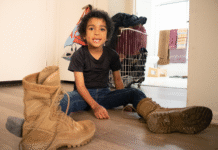Pearls of sweat roll down the sun-drenched arms of Ryan Talbot, 19. The tense muscles of his tangled limbs quake under the weight of his toned frame. After a brief moment of hesitation, Talbot inhales sharply before launching himself upward. Scathing pain twists his calm expression as the rock’s jagged surface scores the skin of his calloused fingers.
This brief discomfort is worth the rush administered to his system while climbing.
Talbot’s love affair with rock climbing manifested during a trip to Joshua Tree with the Boy Scouts. He was 11 years old and terrified of heights. Talbot recalls the fear he felt while staring down the 134-foot descent.
“Getting over that first ledge was hard because I thought I’d slip and fall,” Talbot laughed. “But halfway down I turned and saw the view. After that I was hooked.”
Now an instructor at Boulderdash Climbing in Westlake Village, California Talbot shares his enthusiasm with colleagues and patrons. The highest difficulty grade he has climbed is a 5.11c.
On the Yosemite Decimal System, or “YDS,” a 5.11c would be intermediate. A higher climb grade means a greater fall. Knowing that, he approaches each ascent fully focused. But even with perfect body placement and a secure rope system, accidents happen.
“What we do is dangerous. You will fall, guaranteed. So it’s important to learn how to fall correctly,” Talbot said.
As an instructor, Talbot helps make sure the men and women in his charge are equipped with the knowledge they need.
Central to climbing is the belayer. That person is responsible for securing active ropes, and acts as the brakes in the event of a fall.
“The most dangerous thing you could do as the belay is let go of the rope,” Talbot said.
For added safety, each instructor is paired with another climber. Talbot was assigned his partner in mid-January 2015. Liesbeth Peace, 18, got a taste for climbing while visiting Germany three years earlier.
Waldhochseilgarten Jungfernheide Park near Berlin touts extensive rope and obstacle courses in the forest canopy.
“It was intense climbing across something so far up,” Peace recalled.
Stateside, Peace takes her obsession to new heights. Tightening the laces of her roughed up La Sportiva Mythos shoes, she stands idle at the base of a 65-foot run. The green path labeled “That Ryan T. is so hot right now” is a 5.11 c. Breathing out slowly, Peace begins.
Below her, Talbot quickly reins in the slacked rope. Hopping upward he pulls the bottom length of rope with his right hand as his left swiftly feeds the top end into the belay device. A sudden jerk from above catches Talbot’s attention. Peace has stopped moving.
Caught at the 45-foot marker, Peace dangles from the artificial rock face. She relies on the sticky soles of her shoes to anchor her in place.
Coating both hands in a visible layer of fine white chalk powder, Peace breathes in steadily.
“We have to be really careful with the higher climbs because anything could go wrong,” Talbot said.
Exhaustion is a climber’s mortal enemy. The energy needed to move along a wall is draining. Experts and amateurs alike are not immune to the prolonged strain on their bodies. With holds the size of dimes to hang on to, it’s not long before a climber’s limbs begin to shake.
“It’s you versus you when you climb,” Christiaan Luneberg said. “Everything else is just secondary.”
Luneberg, 47, began climbing after graduating high school. Before opening Boulderdash 10 years ago with business partner Paul Farkas, Luneberg worked a menagerie of jobs. Even so, his passion for the sport does not dissipate.
“I like the climbs that you fall on,” Luneberg said. “If you don’t fall you can’t learn.”
Mellow like the iconic surfers of the 1960’s, Luneberg welcomes patrons with a smile. Slipping away from the front desk, he explores the entire length of the climb zone.
“When I’m walking the gym I keep my eye out for safety hazards or risks,” Luneberg said.
Luneberg calls this having a “belayer’s eye.”
This heightened awareness is demonstrated by all Boulderdash employees. As Talbot works the belay for Peace, he briefly glances to either side.
“I always have my eyes peeled in the off chance that something happens,” Talbot said.
A sophomore studying medicine and neuroscience at Moorpark College, Talbot can administer first-aid care to injured climbers. Since he began working at Boulderdash, he has seen many accidents.
“Most falls hit somewhere on the spine and the back of the head,” Talbot said. “Bouldering is worse because those are full-ground falls.”
The trick to staying on course is to focus. Luneberg, who scaled El Captains’ infamous Dawn Wall twice, veers away from danger by “keeping a clear head.”
“Climbing is all mental,” Luneberg said. “If you think you can’t make it up a climb then you won’t. The biggest issue we all face is psyching ourselves out.”
Despite Talbot’s relative newness, he has adapted to the role of a teacher. Briana Carter, 20, has been close friends with Talbot for six years. She has since noticed subtle differences.
“He was able to talk me up a waterfall and back down it,” Carter said. “That’s a huge accomplishment.”



